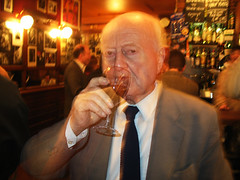
Lost on the moors high above Swaledale, is the Tan Hill Inn - at 1,732ft above sea level, the UK's highest - and it's up for sale. Despite being also one of the remotest pubs anywhere in the country, it's popular all year round. Having the Pennine Way pass the front door can't hurt. The winters up there are legendary. I read once that in the mid 70s the pub was cut off by snow in december, with the Landlord not wishing anyone Happy New Year until a postman got through by Land Rover in April. Presumably they'd been living off pickled eggs and melted snow.
I spent one of the best New Year's Eves I've ever had at the Tan Hill. It was about 20 years ago. A mate and I were invited up by some friends who'd spent the previous summer working behind the bar. It was my first encounter with Theakston's Old Peculiar, so my memories of the night are vague, if warmly pleasant. I do recall that despite a windchill of about minus 10, some people were camping over the road. It was discovered that standing in the screaming gale outside for two minutes sobered you up sufficiently to down Just One More Beer. At one point, a farmer walked in dragging a tent that he'd found stuck to the front of his car several miles away. Having reunited the owner with his accommodation, he and his collie sat down and joined in the fun. I called it a night at about 3am, not quite passing out in the staff quarters upstairs. When I came down for breakfast 6 hours later, apart from folk in sleeping bags on the benches, nearly everyone was where I'd left them, pints in hand.
If you want to buy it, they're asking £1.1 Million. Presumably that price includes a previous landlady who's buried somewhere out the back of the pub.
(photo from eucharisto deo - I lost my camera that night)
_















